Primary producers explain why the supermarket majors and crippling red tape are threatening your right to fresh, local produce.
From mining boom to dining boom: food production is poised to play a key strategic role in WA's future. But will the supermarket giants and big farming be the only players left standing? And what will it mean for WA consumers? The state's primary producers say it boils down to buyer demand for choice.
Big changes are afoot in Australian and WA agriculture. With food security an ongoing global concern and a projected 75 per cent hike in world food demand in the first half of this century, the race is on to meet it.
In Australia, which already produces enough food to feed 40 million people beyond its borders, agriculture is being touted as the key economic engine to replace the slowing mining sector, with the slogan 'dining boom not mining boom' becoming as ubiquitous as the phrase 'food bowl of Asia'.
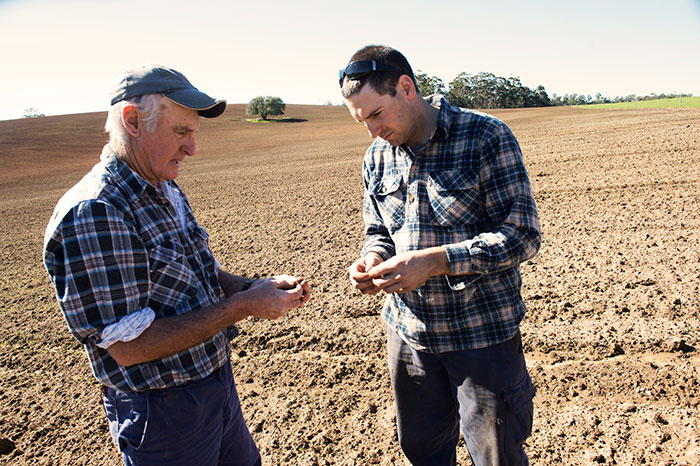
Potato grower Bob Pessotto and his son Carlo have founded a thriving small family business through farmers markets.
But many small WA producers are so busy fighting for survival they doubt they'll have a place at the dining-boom table. Already struggling under the highest regulatory costs in the world, small producers like Treeton dairy farmer Peter Togno of Margaret River Organic Creameries find the notion of WA as an Asian food bowl ludicrous. "There are only 150 of us left in WA and you've got people talking about the food bowl of Asia. I hear that and laugh. We've got no hope. Dairy in WA – conventional diary – is on its knees."
Indeed, the number of dairy farms across Australia has more than halved in the past two decades as demand for cheaper milk has led to ever-greater corporatisation of the dairy industry. "I wouldn't be in the dairy industry today if I hadn't gone organic," says Peter. "I'm fortunate I've got that point of difference. Being organic is very easy to market. We don't homogenise, we don't standardise our milk, so what our cows produce is exactly what goes in the bottle." Building his own processing factory has also meant that, despite his modest-sized herd of 120 Holstein Friesian cows, he's been able to dictate his own terms to independent stores, as well as to Coles. "But if you're out there just trying to sell conventional milk, you're really on a hiding to nothing, because you can't compete with big companies like Harvey Fresh, Brownes and Lions, just on the quantities of scale. So you've got farmers quitting, even industry leaders. Only today another two families near Busselton quit."
And it's not just dairy farmers folding up their tents. The ongoing shift away from small farms to large-scale, corporate-style agriculture has some pundits estimating that much of the nation's farmland could be in the hands of corporate farming operations by 2020.
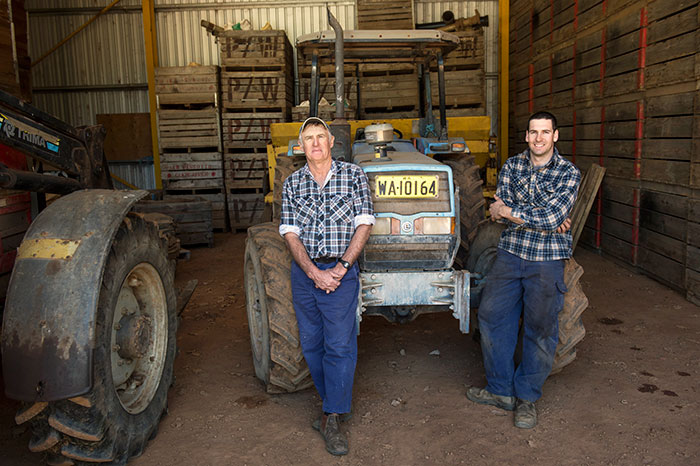
And the stakes are high for WA consumers. A cornerstone of WA's lifestyle is the ready availability of a diverse range of fresh, locally produced fare, the kind you don't find in the shelves of the big two supermarkets where home brands proliferate. It's the kind that can only be found at growers' markets, independent supermarkets and specialty grocers, like fruit fresh from the tree (not aged in storehouses for months), or local grass-fed meats.
But with small local producers under increasing duress from unprecedently high labour and regulatory costs, a crippling duopolistic domestic market and a high Australian dollar, how long can these small producers continue to deliver the diverse range of quality foods we've come to count on?
Small operators are apprehensive, too, about the momentous changes ushered in by the Federal Government's long-awaited Agricultural Competitiveness White Paper. Its goal is to increase farm-gate returns, but many fear its other stated aims of doubling production by 2050 and opening up new areas for agriculture – including in northern Australia – will fuel the march toward food corporatisation.
In WA, iron ore magnate and philanthropist Andrew Forrest has already had the approval of agribusiness leaders and policy makers for his idea that the entire agricultural sector be marketed to China under a common brand. His purchase of Harvey Beef, WA's only licensed beef exporter to China, promises to be a game changer.
A new WA initiative will see $300 million spent over the next five years on 14 programs designed to help WA agriculture capitalise on the wealth of Asia's burgeoning middle class. Funded through Royalties for Regions, it aims to promote local products, attract new investment and strengthen the research, production, and export capacity of WA agriculture. But many fear it will serve the interests of big farming at the expense of small producers. And where will it leave those who farm outside designated areas of future agricultural investment and expansion? As one small grower put it: "Governments talk a lot about the importance of regionality, but if you scratch the surface they don't support small producers."
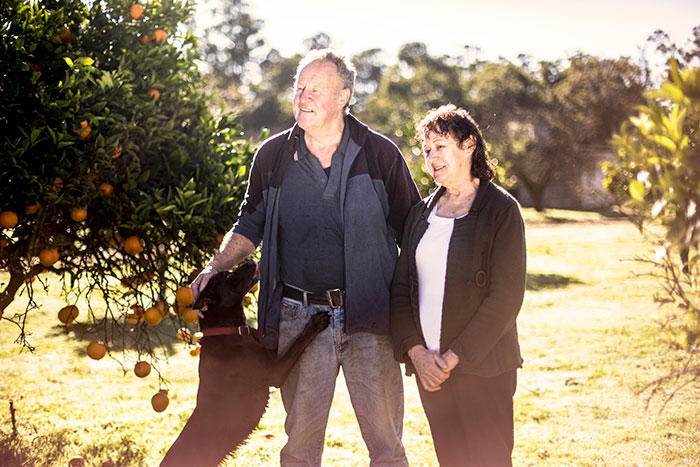
Cambray Cheese's Jane and Bruce Wilde.
Joining the rush to feed China's billions will involve issues of scale and supply chains and, in all possibility, Chinese investment. So far, little mention in the dining-boom debate is made of a ground-breaking 2013 UN Food Report, which sees a return to small-scale regenerative farming systems as the answer to feeding the world, rather than conventional large-scale monocultures. There is concern, too, that not enough is being done to address the uneven playing field of both domestic and export markets. Profit margins of Australian food suppliers are already squeezed between high manufacturing and regulatory costs, and dominant retailers, confirmed this June in a report by the Australian Food and Grocery Council. Council CEO Gary Dawson said the report "indicates that Australia has the highest manufacturing costs in the world, with labour, utilities and regulatory costs among the highest globally".
The Competitiveness and Sustainable Growth Report white paper also found that one dollar in every four earned by suppliers is being returned to retailers to fund discounts, rebates and promotions. Dawson says this represents a direct profit shift from suppliers to retailers and reflects the dominant position of the two major supermarket chains. "The two major retailers extract an additional five per cent more from suppliers than other retailers, reflecting their market power," he says.
For WA potato growers F Pessotto and Sons, that profit shift is very real. "It's becoming increasingly harder to serve Coles and Woollies," says Bob Pessotto, who together with sons Carlo and Frank grows potatoes on the 80ha potato farm his father established 50 years ago near Manjimup. "The margins get tighter and tighter, therefore you've got to find ways of doing more to sustain a viable unit, or find other things to do."
The Pessottos supply to major retailers under licence through the Potato Marking Corporation where demand for perfect, evenly shaped potatoes translates into significant wastage. "This can be up to 20 per cent," says Bob. "It's heartbreaking, but we try to factor that into our costs." They also grow a much wider variety of potatoes than you'll see in supermarkets, but couldn't sell them until they set up a Manjimup Farmers Market stall for charity on behalf of the marketing corporation. They were able to sell different varieties but also smaller, imperfectly shaped potatoes that supermarkets don't want, thereby quadrupling profits, says Carlo. "As well as selling them cheaper than in shops, we were bringing home profits, as opposed to the middleman, then supermarkets taking their share."
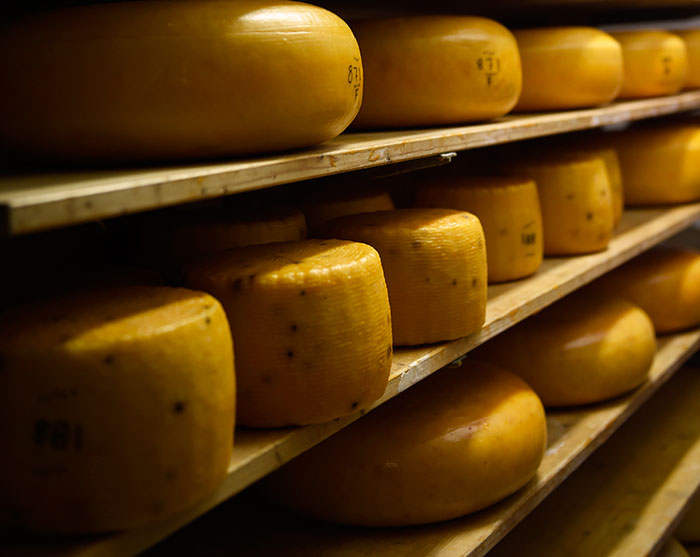
Jane and Bruce Wilde's award-winning product maturing on shelves.
This paved the way for the family's small, thriving seasonal farmers market business, run by Carlo, under the Karri Country Gourmet Potatoes label, and proved Bob's belief that "there is a growing market of people who want to know where their food comes from and how it is grown". This is also borne out by a Colmar Brunton Omnibus Survey, conducted early this year on behalf of the Australian Farmers' Market Association, which found that 14 per cent of Australians now typically buy their vegetables at growers markets. "Just how big that market will grow I don't know," says Bob, who will also continue to sell to supermarkets via the marketing corporation, and who supports its objectives. "I think that the commercial market as it exists now will continue, because the average person will continue to go to Coles and Woollies. And for the small grower, the end game is a losing one, unless consumers support local growers," he argues. "It's all in the hands of the consumer."
He believes the high costs of Australian labour and the need for high volumes – not to mention a high Australian dollar – makes export to Asia unviable for most small farmers. But he's hopeful that "some small, niche markets" might be developed via the new Southern Forests Food Council, which garnered $5 million of the Manjimup shire's Agricultural Expansion Project. This fledgling grower initiative aims to unite the region's diverse food producers, small and large, together with culinary and agri-tourism operators under the Southern Forests brand. It will also develop new domestic and export markets, and value-add opportunities for growers, says its vice president Nicole Giblett, a third-generation apple grower.
"I'm confident that policy makers are now really listening to growers," she says. "I think the lip service era has just about come to an end because of this significant shift in how government is looking at food security. And if we're just given support rather than more red tape, we know we'll make it work."
Red tape – aka compliance – is high on the council's list for urgent reform, says Nicole. "It's about the increasing number of hoops that all Australian growers now have to jump through to have their quality system signed off on. Whenever you go into export or sign up to use the Australian-grown label (even the Buy West Eat Fresh label requires additional grower compliance as well as a fee) or sell into supermarkets or any new market, there's a new load of paperwork, and it has passed the ridiculous point. It's almost the last straw for some growers. It's very disheartening when you see imported product come in either labelled, or in worst cases not labelled, like frozen vegies coming from China into New Zealand, into supermarket freezers, and you know that they haven't been made to jump through the same hoops."
In the four years since Peter Togno of Margaret River Organic Creameries established his milk-processing factory on the Treeton family farm, the costs of compliance "have gone up every year. It's very frustrating and very costly. The government keeps on talking about how they're going to simplify things, but it's just talk".
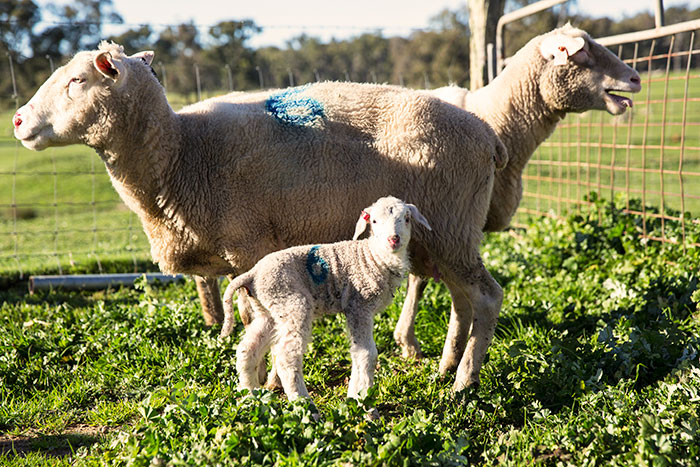
The sheep that provide the milk for their hand-made Cambray Cheese.
For Jane Wilde of the small, award-winning Nannup-based farmhouse cheese-making company Cambray Cheese, the additional hoops required to comply with amendments to the Australia New Zealand Food Standards Code of 2008 (which were only enforced in 2010/2011) are " just ridiculous".
"Auditing and paperwork alone is costing $3000 to $5000 a year," she says. "Little factories can't stand that cost. You do need an extensive food safety program and when we first built our factory the rules and regulations were onerous, but now it's even harder.
I think anyone starting up now would find it really difficult." If Jane, a retired nurse,
and her husband Bruce, a retired policeman, had to start all over again now, she adds, "we probably wouldn't. But we're locked in now because we've got debt to pay off – and I still enjoy making cheese."
Too small to supply to supermarkets, Cambray has carved out a strong, loyal niche market for its handmade cheeses – particularly for its sheep-milk cheeses – at select independent stores, but mainly at farmer's markets. "You have to find your own niche," says Jane, "and we've got a niche because a lot of people prefer sheep-milk cheese because of intolerance to cow's milk, but many are put off by the expense. Our cheeses are probably four times dearer than imported cheese, but you can't compete, they're subsidised. If we didn't have expensive cheeses we wouldn't be here, and if we didn't have farmers markets we wouldn't be here. That's what keeps the business afloat."
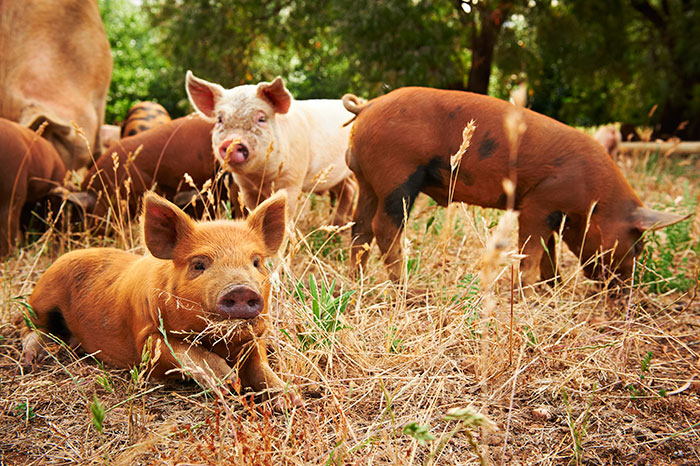
The free-range herd that provides a growing band of top chefs with boutique pork.
And you won't find David Hohnen's Big Red pork in supermarkets, or even in independent providores. Highly sought-after by top chefs, and sold under the Big Red label solely at Margaret River Farmers Market, this unique free-range pork – produced from a tiny, 40-strong herd of breeding sows on a small Margaret River farm using organic principles (a farm that once produced grapes for the family venture, McHenry Hohnen Wines) – gives new meaning to the word 'boutique'. "It's fair to say most commercial farmers would have a bit of a giggle," says the renowned Cape Mentelle and Cloudy Bay winemaker, who also produces a small range of small goods under The Farm House label, which are sold in select independent stores.
Like those of many small WA farmers, David's farm is in many ways a model of the sustainable regenerative small-scale production systems hailed in the 2013 UN food report. But it's not easy producing high-quality food on a small scale when 85 per cent of people prefer supermarkets for convenience and price, says David. "I'm not complaining. We've given people a choice, but you can't put 'good' and 'cheap' in the same paragraph, so I think the future is with the consumer." He also credits the survival of his meats to Dardanup Butchering Company "who still look after little producers, but there's still massive vulnerability for people like us as the cost of compliance for abattoirs is so massive you're more likely to hear of an abattoir shutting down than starting up. There are lots of people around Margaret River who'd love to be doing poultry on a small scale but can't because there's no poultry abattoir."
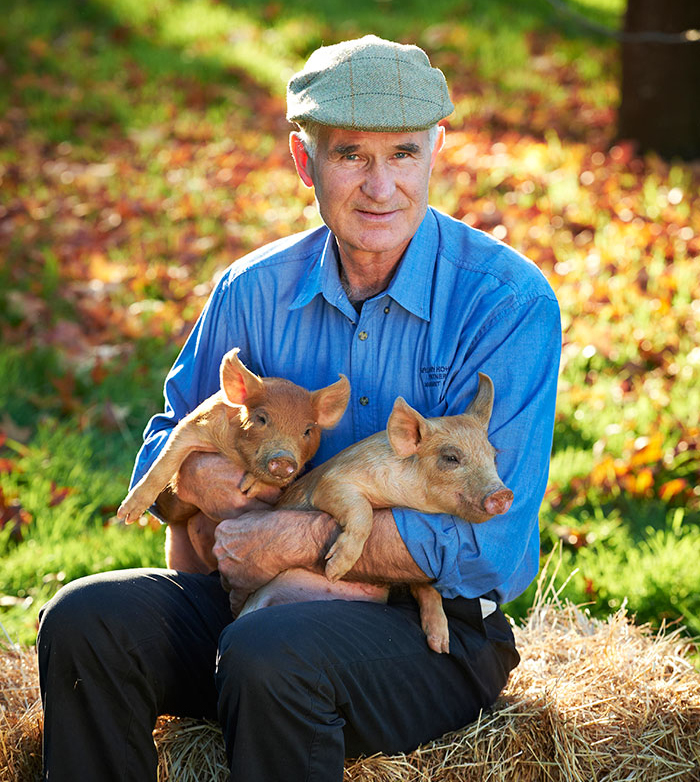
Pork grower David Hohnen with pampered young members of his prized flock.
Rising land values in Margaret River, too, mitigate against the profitability of small-scale farming which is why, in part, there is heavy investment in the Gascoyne, a powerhouse of WA horticulture. Its $25 million Gascoyne Food Bowl project is designed to boost production with a 400ha horticultural expansion, plus a shoring up of water resources. "We don't have the same pressures on land use for lifestyle housing and we have a climate that's spot on," says project manager, Tony Della Bosca. "About 95 per cent of the product grown here goes into WA and we're looking to expand to develop new export markets in Asia and the Middle East and fill gaps in the domestic market. Eggplant, for example, is something the eastern states have to buy overseas in the off-season, whereas we can grow them easily."
With Woolworths and Coles now buying around 95 per cent of their produce direct from large-scale growers or from successful grower cooperatives, many of the region's smaller producers face a stark choice.
"They either need to sell out, or work cooperatively to get the market's attention, or they need to find their own boutique market such as a hotel chain or something, because when they go to the market floor, it's the independents who hammer them on price," says Tony. "Supermarkets are a necessary evil, and if growers have a voice, they have an option. When someone tries to screw the price down too low, they can actually say, 'Well, we're big enough to get our own contract somewhere else,' and do that. And that is becoming increasingly imperative, right across the board, and especially down south. If you haven't got a voice, you are going to get slaughtered, sooner or later.''
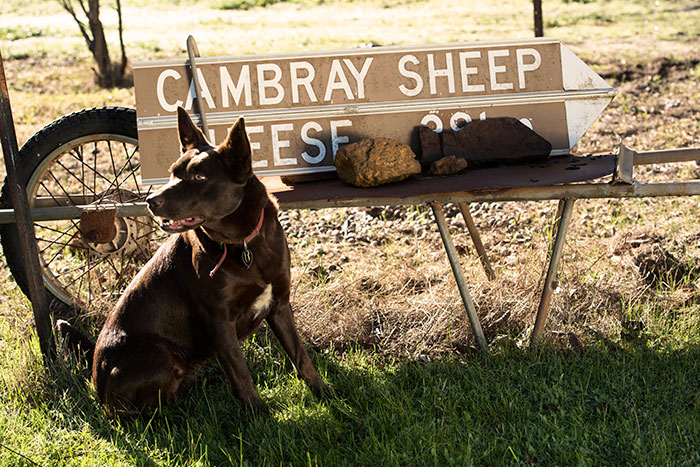
Cambray farm dog and mascot Kelly at the farm gate.
But independent supermarkets and providores remain a viable alternative market for small growers, most of whom buy direct from smaller operators. Baldivis tomato grower Yoshihisa Okuma's 7ha Okuma Farm sells the highly sought after 'momoko' grape tomatoes direct to IGA Wembley, commanding a fair price. Established 10 years ago as part of a WA Agriculture Department initiative to promote joint ventures between Japanese and local growers, Okuma Farm recently established another 7ha tomato farm in Carnarvon with a view to exporting, says farm manager Shigeo Kogota. "We don't yet have enough quantity and the biggest issue is the cost of labour."
Meanwhile, independent supermarkets like IGA are being squeezed by Coles and Woolworths as giant German-owned supermarket chain Aldi enters WA. Aldi has spared the profits of the big two elsewhere in Australia but has eaten into IGA's market share. "On some of the pricing that Coles and Woolworths sell for, we can't even buy it," says Vince Belladonna, manager of IGA Wembley. "So we look at it as we offer an alternative. Without the IGA stores, too, he adds, "growers would be in a very precarious position, relying on the smaller deli-type convenience stores".
Just how far down the road of ever-cheaper, mass-produced, industrialised food we've yet to travel is a moot point. Many growers believe that consumer demand for fresh local foods is the key to halting the march. Others say the drive to meet supermarket prices will lead to further farm closures and food industrialisation. "Supermarkets are not going to go away," says food providore Katrina Lane, proprietor of Taste of Balingup and co-founder of Food Land Culture, a small business dedicated to restoring and revitalising the age-old link between consumers and growers. "Every time we go into them we can make a choice."
Consumers can help counter the trend by choosing to shop at independent supermarkets, providores and farmers markets. While labels like MSC and Buy West Eat Fresh can support informed decision-making, growers remind us that authentic, fresh, locally produced food may cost a little more, but tastes better, lasts longer and shores up our health and our future.
.jpg)
A platter of award-winning fare.